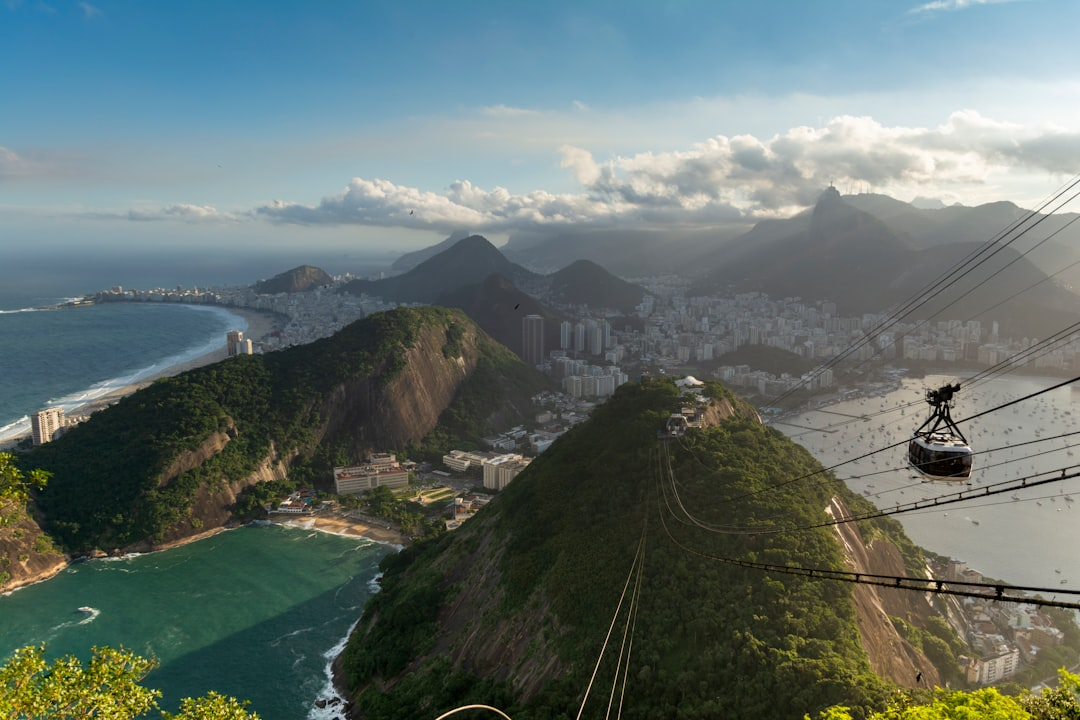
Photo by Raphael Nogueira on Unsplash
With its sandy beaches, soaring mountains, and picturesque harbor, Rio de Janeiro truly lives up to its nickname as the “marvelous city.” Facing the South Atlantic coast, Rio is Brazil’s second-largest city and is renowned worldwide for its stunning natural setting. The dazzling landscape is just one of the many reasons visitors flock to this vibrant metropolis. From the rhythmic beats of samba during carnival season to the tranquil beauty of its lagoons and beaches, Rio offers an unforgettable experience for all who visit.
In this comprehensive guide, inspired by the insightful travel video created by touropia, we explore the Top Tourist Attractions in Rio that you simply cannot miss. Whether you’re an adventure seeker, a culture enthusiast, or someone looking to relax by the sea, Rio de Janeiro has something spectacular to offer.
1. Barra de Tijuca Beach: Rio’s Longest and Cleanest Shoreline
Starting our list at number ten is Barra de Tijuca Beach, a true haven for beach lovers seeking a less crowded and more pristine coastal experience. Stretching longer than any other beach in Rio, Barra de Tijuca boasts clean white sands and is renowned for having some of the cleanest waters compared to the more famous Ipanema and Copacabana beaches.
Unlike the bustling tourist hotspots, Barra de Tijuca attracts a more active crowd. Here, kite surfers and body surfers take advantage of the favorable winds and waves, turning the beach into a vibrant playground for water sports enthusiasts. The surrounding area is also the youngest in Rio, having been developed about thirty years ago, which gives the neighborhood a modern vibe combined with natural beauty.
![]()
2. Lagoa Neighborhood: Exclusive Elegance by the Lagoon
At number nine, the Lagoa neighborhood stands out as the most exclusive area within Rio’s affluent Zona Sul district. In fact, it ranks as the third most expensive neighborhood in all of South America. Central to Lagoa’s charm is the magnificent Lagoa Rodrigo de Freitas, a large lagoon encircled by a scenic four-mile path popular among joggers and cyclists.
Visitors and residents alike enjoy the open-air cafes and restaurants lining the lagoon’s edge, offering breathtaking views of the water and the beaches beyond. The tranquil environment combined with luxurious living spaces makes Lagoa a perfect destination for those looking to experience Rio’s upscale lifestyle amid natural beauty.
![]()
3. Maracanã Stadium: The Heart of Brazilian Soccer
No visit to Rio de Janeiro is complete without experiencing the iconic Maracanã Stadium, ranked number eight on our list. Soccer, or futebol as it’s locally known, is more than just a sport in Brazil—it’s a passion that unites the nation. The Maracanã stadium is a symbol of this passion and one of Rio’s most significant landmarks.
When it first opened in 1950, the stadium could hold nearly 200,000 spectators, making it one of the largest stadiums in the world. Today, for safety reasons and comfort, the capacity has been reduced to around 80,000 seats. The stadium underwent extensive renovations for the 2014 FIFA World Cup, solidifying its status as the largest stadium in South America.
Visiting Maracanã offers a glimpse into Brazil’s vibrant sporting culture and the electric atmosphere of a live soccer match.
![]()
4. Tijuca National Park: A Lush Urban Forest Adventure
At number seven, Tijuca National Park is a sprawling urban forest that covers a vast, mostly mountainous area within Rio. It is one of the largest urban forests globally and a vital green lung for the city. Visitors can hike to Rio’s highest peak, Pico da Tijuca, to enjoy breathtaking panoramic views of Guanabara Bay and the sprawling cityscape below.
The park has a fascinating history. In the early 1800s, much of the forest was destroyed to make way for coffee plantations. However, in the latter half of the century, an ambitious reforestation effort replanted approximately nine million trees by hand, restoring this vital ecosystem.
Nature lovers will appreciate attractions such as the enchanting pink Meering Chapel and several stunning waterfalls scattered throughout the park, making Tijuca a peaceful retreat from the urban buzz.
![]()
5. Lapa Neighborhood: Rio’s Nightlife and Cultural Hub
Number six on our list is the Lapa neighborhood, located in downtown Rio. Once known as the city’s red-light district, Lapa has transformed into a vibrant cultural and nightlife hotspot. On weekend nights, the streets come alive with samba and choro music spilling out from local bars, creating a festive atmosphere that captivates both locals and tourists.
The neighborhood’s architecture, mostly dating back to the 1800s, provides a historic and scenic backdrop for its lively festivals and gatherings. One of Lapa’s most famous landmarks is the Escadaria Selarón, a colorful set of steps that connects Lapa with the bohemian Santa Teresa neighborhood.
It’s also the perfect place to enjoy a caipirinha, Brazil’s national cocktail made from sugarcane liquor, sugar, and lime, while soaking in the infectious energy of Rio’s nightlife.
![]()
6. Jardim Botânico: A Botanical Wonderland
Ranked number five, the Jardim Botânico, or Botanical Gardens, is located west of the Lagoa neighborhood and is a must-visit for nature enthusiasts. Established in the early 1800s, the garden is home to over 8,000 species of plants, including majestic palm tree avenues and an impressive collection of orchids—over 600 species to be exact.
The garden is more than just a plant collection; it features monuments, fountains, and themed areas such as a serene Japanese garden and a pond filled with water lilies. The on-site museum offers educational exhibits focusing on environmental conservation, making Jardim Botânico both a beautiful and informative destination.
![]()
7. Sugarloaf Mountain: Iconic Views Above Guanabara Bay
At number four, Sugarloaf Mountain rises dramatically 1,300 feet above the mouth of Guanabara Bay. This striking monolith of quartz and granite is accessible via a glass-walled cable car system known locally as the bondinho or teleférico.
The journey begins at the base of Babylonia Hill, where the first cable car ascends to the top of Morro da Urca Hill. From there, visitors transfer to a second cable car that climbs to the summit of Sugarloaf Mountain, rewarding them with spectacular 360-degree views of Rio’s beaches, cityscape, and bay.
This attraction is a highlight for photographers, nature lovers, and anyone wanting to witness Rio’s breathtaking natural beauty from above.
![]()
8. Ipanema Beach: The Legendary Shoreline of Bossa Nova
Number three on the list is Ipanema Beach, famous worldwide thanks to the classic Bossa Nova song “The Girl from Ipanema” from the 1960s. Today, it remains one of Rio’s most popular tourist destinations.
The beach stretches in a long, arching curve of soft white sand and gentle waves, consistently ranking among the best beaches globally. The surrounding neighborhood features a well-organized grid of shops, restaurants, art galleries, and clubs, making it a lively and sophisticated area.
Sections of the beach are marked by numbered posts, helping visitors choose their preferred spot. Families tend to gather between posts 11 and 12, while post 9 attracts dedicated sunbathers and creative artists, contributing to the beach’s diverse and welcoming atmosphere.
![]()
9. Copacabana Beach: The Active Heartbeat of Rio’s Coastline
Just west of Ipanema, separated by the surfer favourite Arpoador Beach, lies Copacabana Beach, ranked second on our list. Copacabana offers a more vibrant and active vibe than its neighbour, with cariocas (locals) often engaged in lively games of soccer or volleyball on the sand.
Vendors roam the beach selling drinks and snacks, adding to the festive atmosphere. The famous promenade that borders the 2.5-mile-long beach is a favourite spot for both visitors and locals to take leisurely strolls. Built in the 1930s, the walkway features a distinctive wave-like pattern laid out in black and white stones, embodying Rio’s artistic flair.
Behind the promenade, a dense cluster of multi-storey hotels and apartments rises, showcasing the city’s blend of natural beauty and urban living.

10. Christ the Redeemer: Rio’s Iconic Art Deco Statue
At the pinnacle of our list, number one, stands the world-famous statue of Christ the Redeemer (Cristo Redentor). Perched atop the 2,330-foot high Corcovado Peak, the statue’s outstretched arms seem to embrace the entire city below.
Construction began in 1922 during the height of the Art Deco movement, and the statue is considered the largest Art Deco statue in the world. Made of concrete and soapstone, it has become a symbol of Rio de Janeiro and Brazil itself.
Most visitors reach the base of Corcovado Peak via a vertical cog railway. While the original climb to the statue involved hundreds of steps, modern elevators and escalators now make the ascent more accessible, allowing everyone to enjoy the breathtaking views and the monument’s serene presence.
![]()
FAQ: Your Questions About Rio’s Top Tourist Attractions Answered
What is the best time of year to visit Rio de Janeiro?
The best time to visit Rio is during the Brazilian summer months from December to March, especially if you want to experience the world-famous Carnival. However, the weather is pleasant year-round, so you can enjoy the beaches and outdoor attractions at any time.
Are Rio’s beaches safe for swimming?
Generally, beaches like Ipanema, Copacabana, and Barra de Tijuca are safe for swimming, with lifeguards on duty. However, always pay attention to local warnings and avoid swimming in areas with strong currents or pollution.
How do I get to Christ the Redeemer?
The most popular way to reach Christ the Redeemer is by taking the cog train from the Cosme Velho neighborhood. Alternatively, you can drive or book a guided tour. Elevators and escalators at the summit make the final ascent easier.
Is it necessary to book tickets in advance for Sugarloaf Mountain?
While you can buy tickets on-site, it’s recommended to book in advance during peak tourist seasons to avoid long lines. Early morning or late afternoon visits offer the best lighting and smaller crowds.
What activities can I do in Tijuca National Park?
Tijuca offers hiking trails, bird watching, waterfall visits, and scenic viewpoints. It’s perfect for outdoor enthusiasts looking to explore Rio’s natural beauty without leaving the city.
Conclusion: Experience the Marvelous City’s Best
Rio de Janeiro is a city that effortlessly combines natural beauty, cultural richness, and vibrant urban life. From the sprawling beaches of Barra de Tijuca and Ipanema to the towering heights of Sugarloaf Mountain and Christ the Redeemer, every corner of Rio offers something unforgettable.
Whether you want to dive into the rhythm of samba in Lapa, marvel at the lush greenery of Tijuca National Park, or soak up the sun on Copacabana’s lively shores, Rio’s top tourist attractions promise a remarkable journey. Planning your visit around these highlights will ensure you capture the true spirit of this marvelous city.
Start your adventure in Rio de Janeiro today and discover why it remains one of the world’s most beloved travel destinations.


